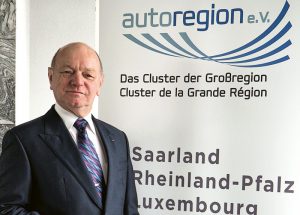Notes on the automotive drive system of the future.
By Armin Gehl, Managing Director of autoregion e.V. Saarbrücken.
 One thing is beyond question – continuing as before in the transport market is not an alternative. That something has to be done is beyond dispute. Car exhaust fumes account for around 30 percent of all CO2 emissions in the EU. Car and truck traffic account for 72 percent of this. Despite increasingly efficient engines, there is no real improvement. At the same time, cars have become heavier and heavier and traffic performance has increased significantly overall. The technological increase in efficiency is literally fizzling out. And the EU has set itself the goal of reducing traffic emissions by 60 percent compared with 1990.
One thing is beyond question – continuing as before in the transport market is not an alternative. That something has to be done is beyond dispute. Car exhaust fumes account for around 30 percent of all CO2 emissions in the EU. Car and truck traffic account for 72 percent of this. Despite increasingly efficient engines, there is no real improvement. At the same time, cars have become heavier and heavier and traffic performance has increased significantly overall. The technological increase in efficiency is literally fizzling out. And the EU has set itself the goal of reducing traffic emissions by 60 percent compared with 1990.
There is disagreement about the right way out of this dilemma – often between politicians and experts. Unfortunately, the discussion is not always characterized by scientific objectivity. Self-proclaimed guardians of the Grail of nature conservation are driving politicians and local authorities ahead with court decisions on driving bans. All too often, business interests or political sensitivities obscure the view of pragmatic and goal-oriented solutions. The result is: customers are irritated and react with buying restraint.
Take the example of “diesel”: The share of diesel vehicles in new registrations fell from a good 50 percent in 2015 to only about 30 percent in October 2019. Unfortunately, the accusation that the automotive industry has largely caused the diesel engine’s image loss itself through the diesel scandal cannot be completely dismissed. However, there is a consensus among experts that the diesel engine is an indispensable element on the road to achieving the climate targets.
Because of its more efficient combustion due to the compression ignition system, the diesel engine has an advantage of around 15 percent over the gasoline engine in terms of CO2 emissions, despite its higher carbon content. A further advantage of the diesel is the significantly lower particulate emissions of modern Euro 6 class diesel engines. Recent studies have shown that the exhaust gases of a more modern diesel engine are cleaner than the environmental air drawn in for combustion. However, there is no denying the fact that nitrogen oxide pollution is increasing as a result of improved combustion values. Euro 6 engines counter this phenomenon with active DeNOx exhaust gas aftertreatment.
If one follows the signals from politics, electric drive seems to be the ideal way to achieve the climate targets. In the meantime, all well-known manufacturers have e-models in their product portfolio or are developing entire product ranges with electrically powered vehicles. Looking at the registration statistics, the pure electric drive seems to be gradually gaining ground. Since 2015, the number of new registrations of electric vehicles has almost tripled and will reach a new record level of over 53,000 units in 2019. This puts the market share of electric vehicles at 2.6 percent in Germany, but still well behind the Netherlands with 9 percent or China with 4.7 percent market share. Norway continues to hold the absolute top position in an international comparison with a market share of 61 percent. However, the example of Norway shows the questionability of such comparisons. There, the high market share is due to extensive government support measures for e-mobility, which were mainly financed by the sale of oil and natural gas, which then quenches the thirst of classic combustion engines elsewhere in Europe.
Some manufacturers – including VW – have geared their product strategy entirely towards battery electric drive systems. VW intends to sell 22 million battery electric vehicles worldwide by 2028. Other manufacturers are committed to greater technological openness and are also developing battery-independent electric drives.
At the forefront of this trend are drives that work with hydrogen fuel cells. Fuel cell technology is not new. Intensive research has been conducted on it since the mid-1990s and it was long considered the drive alternative to the classic combustion engine. Its main advantage is that the drive is absolutely emission-free. Only water vapour escapes from the exhaust. The fuel cell is also ahead of the battery electric drive in terms of range and duration of the refuelling process.
A further aspect is particularly important for employees in the automotive industry and its suppliers, since the production of fuel cell technology is in many respects structurally and from a manufacturing point of view similar to that of the combustion engine. The fuel cell requires significantly more metallic components than a battery electric drive. The added value that exists primarily in the supply industry could be rededicated within the industry and thus at least partially secured.
The fact that fuel cell technology does not require a battery is a very important aspect for the operation of commercial vehicles. The batteries, which are still very heavy for long ranges, reduce the payload required for economical operation. The long charging times of the batteries reduce the operating times and call into question the economically sensible use. This is a strong indication that hydrogen as an energy carrier will be indispensable in the future, especially in long-distance and heavy-duty transport.
The German government has now also taken this into account. For example, the purchase premium of € 6,000 is explicitly also valid for cars with fuel cell drive. An incentive programme for commercial vehicles is currently being planned. Here, too, the Federal Government will not be able to avoid promoting hydrogen technology. Also the use of synthetic fuels would have to be considered by the politicians, because then we would have an immediate reduction of CO2 and the technology of the burner would not be questioned.
If the German automotive industry wants to maintain its leading international position, it must commit itself to technological openness with regard to the development of non-fossil propulsion systems. This can be seen by taking a look at the main sales markets. China, the world’s largest market, has probably committed itself to battery electric mobility due to government regulation. The North American market also appears to be tending in this direction. In view of their scarcity of raw materials, countries such as Japan and South Korea think much more openly about technology and rely on battery-independent drive systems such as hydrogen technology. To be able to serve all markets worldwide, the German automotive industry needs differentiated products in all drive systems. Only in this way will we be able to maintain our export and thus our international competitiveness.


